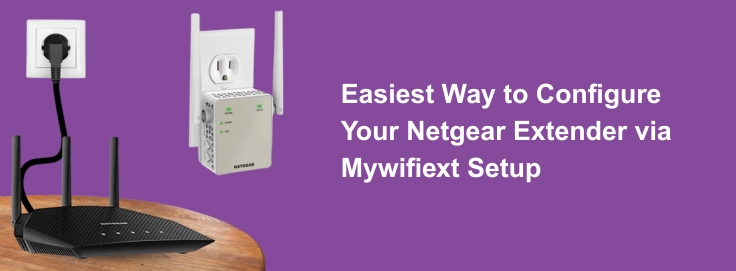Netgear extender setup shouldn’t be difficult. Most people tend to get stuck because no one explains it clearly, not because it’s hard. That’s our purpose. If you’ve got a Netgear extender sitting there blinking at you, and you’re wondering where to even start, relax. It’s actually way simpler than it looks. In this guide, we’ll Walk you through the easiest way to get your extender up and running using mywifiext.
What went wrong?
First, you need to know what Mywifiext is. It isn’t a webpage on the web. You won’t be able to locate it on Google. You can’t even open it while you’re connected to your usual WiFi. This is a site for setting things up locally. You can only use it while you’re connected to the extender’s network, which is generally named NETGEAR_EXT or something like that. If .net doesn’t work, Mac users may use mywifiext.local.
If your browser indicates it can’t get to this page, it’s not broken. You are just on the incorrect network. It happens to everyone the first time.
Check that your extender is plugged in
First, plug it in close to your router. Don’t put it in your dead zone room yet. Hold on. Wait a second. One or two minutes. The power LED should cease flickering and become a solid green or white color. Check the outlet if nothing lights up. It’s that easy sometimes.
If the LED flashes strangely, don’t worry. Some models flicker when turned on. Wait to see if it turns solid.
Link up with the extender’s network
Open the WiFi list on your phone or laptop. Find NETGEAR_EXT and connect. At this point, there is usually no password. If your gadget shows anything like “Sign in to network,” that’s excellent. If not, open your web browser and type:
“mywifiext.net”
Doesn’t work? Okay. Try using “192.168.1.250” If .net doesn’t work, this always does.
If you need to, restart your device
The browser won’t work sometimes. Don’t resist it. Shut it down. Turn off your phone or laptop and then back on. Reconnect to NETGEAR_EXT. Please open the page again. It works around 90% of the time.
Look at your WiFi settings
When you go to the configuration page, it should say something like “New Extender Setup.” Hit it. You will have to type in your admin login and password. This is not the password for your WiFi. This is for the dashboard of the extender. Choose something you can remember. Or write it down someplace, since you can forget.
Next, it will hunt for WiFi networks that are open. Look for your home network. If your router has 2.4GHz and 5GHz bands, both may appear. Connect both for maximum coverage.
Be cautious when you type in your WiFi password. Half of the installations are ruined by caps lock issues. Really. Make sure the spelling is correct.
Then choose a name for your new network. You may keep it as Home Network_EXT or change the name. It doesn’t matter, just make it clear. Press Next. The extension will try to connect. It usually takes around a minute.
Reasons that are common Mywifiext won’t function
You done all that, but Mywifiext still won’t open. Why? This is what generally happens:
- You’re still on the wrong network; you’re still on your primary WiFi.
- Problems with the browser cache-try using Incognito mode.
- The firmware is out of current. Check to see whether your extension needs an upgrade.
- VPN or firewall problems-turn them off for a short time.
- Problems with your device: Sometimes your phone or laptop has to forget the previous network and connect again.
If nothing works, you may reset the extension to its factory settings. Press and hold the reset button for 10 seconds, until the LEDs flash. Then, start afresh. Annoying, yet frequently essential.
Look at the LED lights
Check the signal LED once you’ve connected. Green indicates a solid connection. Weak = orange. Red means too far away from the router.
Move your extender as needed. Some individuals say it helps to position it too near to the dead zone. Nope. Usually, the optimal place is halfway between the router and the weak area.
Update the firmware
Check the firmware anyway, even if everything works. Mywifiext may stop working for no reason if the firmware is old. Check for changes on the mywifiext setup page. Put them in. Yes, it takes a little while. Yes, it’s bothersome. Do it anyhow.
Check the connection
After everything is set up, unplug from NETGEAR_EXT and plug into your extended network. Look at few websites. Watch a video. Check for dead zones. Do Step 5 again if anything is still wrong. You sometimes simply have to do it again.
Quick tips
- For setup, always connect the extender very close to the router. Later, move it.
- Turn off mobile data while you put it up.
- Don’t type mywifiext.net when you’re on your primary WiFi. Not going to work.
- If .net doesn’t work, try 192.168.1.250.
- Incognito mode might help with strange problems with your browser.
- If nothing else works, do a factory reset.
Why Mywifiext?
Some people wonder why not simply use WPS or the app. Well… Mywifiext lets you have complete control. You can examine how strong the signal is, inspect devices, update firmware, and manage your expanded network. Sometimes apps don’t function well, and WPS may be hard to understand, however Mywifiext always works if you follow the directions.
In conclusion
Mywifiext may be annoying. It won’t load, your gadget acts up, and the LEDs flicker in strange ways. It occurs to everyone. But if you do what I said above:
- Connect to the correct network
- Wait for the lights
- Type in passwords carefully
- Look for problems with the firmware and browser
It will work for you. Mywifiext accomplishes what it’s meant to do, dead zones go away, and WiFi becomes stronger.
And what if it doesn’t work again? Start again, reconnect, and try again. That’s how it is with extenders. At least you know precisely what to do now, step by step.


